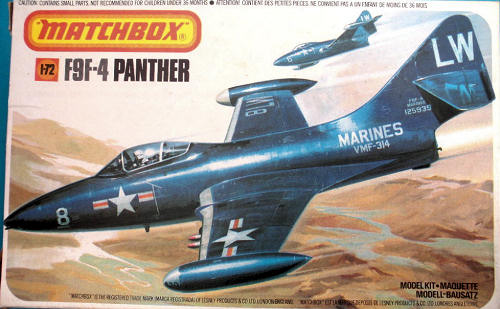
| KIT #: | PK-124 |
| PRICE: | $Currently out of production. |
| DECALS: | Two options |
| REVIEWER: | Victor Scheuerman |
| NOTES: | Only injected -4 Panther in this scale and rather nice |

| HISTORY |
Towards the end of
WW II the U.S. Navy produced outline requirements for two jet powered night
fighters and Grumman proposed a complex aircraft with four Westinghouse
engines rated at 1500 lb thrust each. This aircraft was ordered as model
G-75 with the designation XF9F-1 in April 1946 but this project was
cancelled in October of the same year. During 1946 Grumman had continued to
discuss various proposals with the Navy and model-79D powered by a Rolls
Royce Nene was selected for further detailed work. A contract was finally
placed for this aircraft as the XF9F-2, a completed mock-up being inspected
in January 1947. The Nene was to be produced under license, but the Allison
J.33 was selected as an alternative engine.
On November 24, 1947
the prototype was rolled out and flown.
The first production machines flew one year later and these aircraft
started to reach the operational squadrons in May 1949. The prototype
aircraft did not have the wing tip fuel tanks but these were added to
production models after the first twelve. After considerable development
including more powerful engines and an increase in fuselage length, the -4
and -5 variants were produced. The -5 deliveries started in early 1950.
Panthers of various marks were used extensively throughout the Korean
conflict primarily as fighter-bombers.
Panthers were also used with great success by the Blue Angles aerobatic team until 1954. A total of 1,385 Panthers of all variants were produced. (Thanks to the kit instruction sheet.)
| THE KIT |
 Matchbox’s
unique 1/72 -4 Panther has a total of 74 individually molded parts including
one clear one-piece canopy. There is only a minute amount of flash on this
kit, but there are some sink marks on the intake lips. The surface is a
combination of very petit raised and not over stated engraved panel lines.
In fact, the latter are limited to control hinges, gear doors, nose radome
and the auxiliary intakes on the top of the aft fuselage.
Matchbox’s
unique 1/72 -4 Panther has a total of 74 individually molded parts including
one clear one-piece canopy. There is only a minute amount of flash on this
kit, but there are some sink marks on the intake lips. The surface is a
combination of very petit raised and not over stated engraved panel lines.
In fact, the latter are limited to control hinges, gear doors, nose radome
and the auxiliary intakes on the top of the aft fuselage.
This has to be one of Matchbox’s best cockpits. It starts off with a properly configured tub that has raised detail on the side consoles. Into the tub fit a control column, basic ejection seat and well sculptured pilot. The final parts are a separate instrument panel with raised dots representing the individual instruments and a gun site.
All the gear bays
are fully framed in and the main gear inner doors are molded closed. All the
gear doors would look a little better with a light sanding to make them
thinner. The nose gear has the tire molded with it while the main landing
gears are separate struts and tires and all are adequate.
 Matchbox
was generous with the external stores that include a mix of six HVAR rockets
and four bombs complete with separate pylons. Two nice options are the
ability to fold the wings and to pose the separate speed brakes opened.
Final parts are the arrestor hook, intakes lips and wing fences. The latter
really should be sanded much thinner.
Matchbox
was generous with the external stores that include a mix of six HVAR rockets
and four bombs complete with separate pylons. Two nice options are the
ability to fold the wings and to pose the separate speed brakes opened.
Final parts are the arrestor hook, intakes lips and wing fences. The latter
really should be sanded much thinner.
Assembly is covered in 10 well illustrated steps and the decals placement is covered with four drawings. There are two decal options with this boxing and both are in overall Glossy Sea Blue. One is a post-war Marine Panther of VMF-314 stationed at Cherry Point circa 1954. There is no unit insignia, just the white unit codes. The second option is for No 3 of the blue Angles with their normal yellow trim. The decals still look good after all these years.
| CONCLUSIONS |
Another much under appreciated effort by Matchbox. If you are into 1/72 scale, take the time to trace this one down!
October 2008
If you would like your product reviewed fairly and quickly, please contact me or see other details in the Note to Contributors.